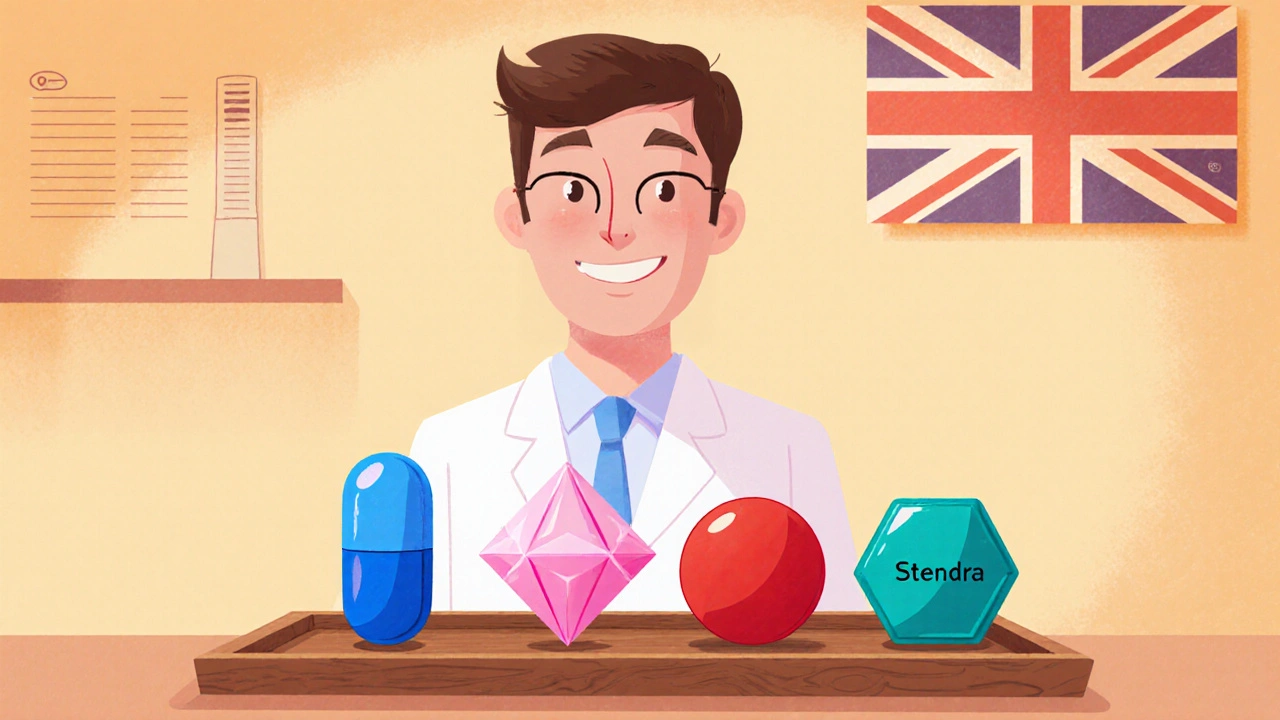Tadalafil: A Practical Guide to Uses, Safety, and Interactions
When working with Tadalafil, a long‑acting phosphodiesterase‑5 (PDE5) inhibitor approved for erectile dysfunction (ED) and benign prostatic hyperplasia (BPH). Also known as Cialis, it relaxes smooth muscle in the penis and prostate, allowing better blood flow and easier urination. Because it stays active for up to 36 hours, many call it the “weekend pill.” Tadalafil fits into a broader class of medicines that share a similar chemistry and therapeutic goal.
The class itself, PDE5 inhibitors, includes drugs like Sildenafil (Viagra) and Vardenafil (Levitra). All of them block the enzyme phosphodiesterase‑5, which normally degrades cGMP, a molecule that helps blood vessels relax. By preserving cGMP, these agents boost nitric‑oxide‑mediated vasodilation, mainly in the penile tissue. This shared mechanism means that knowledge about one drug often applies to the others – a useful shortcut when comparing dosing schedules or side‑effect profiles.
How Tadalafil Relates to Erectile Dysfunction and Cardiovascular Health
Erectile dysfunction, the inability to achieve or maintain an erection sufficient for sexual activity is more than a bedroom issue; it frequently signals underlying vascular problems. Studies show men with ED have a higher risk of heart disease, hypertension, and diabetes. Because Tadalafil works by improving blood flow, it can sometimes reveal hidden cardiovascular concerns when a man notices an unexpected improvement or persistent lack of response. Physicians therefore often screen for heart conditions before prescribing any PDE5 inhibitor.
Another related condition is benign prostatic hyperplasia, a non‑cancerous enlargement of the prostate that causes urinary symptoms. Tadalafil’s smooth‑muscle relaxation effect eases bladder outlet obstruction, reducing urgency and weak stream. This dual‑action makes it a convenient option for men who suffer from both ED and BPH, cutting down on the number of pills they need to take each day.
When considering safety, the most common side effects are headache, flushing, indigestion, and back pain. These usually appear within a few hours after dosing and fade within 24 hours. Rare but serious reactions include sudden vision loss, hearing changes, or priapism (an erection lasting longer than four hours). Anyone experiencing these should seek medical help immediately. Because Tadalafil is metabolized by the liver enzyme CYP3A4, drugs that inhibit this enzyme (like ketoconazole or certain antibiotics) can raise Tadalafil levels and increase side‑effect risk.
Interaction checks are a key part of prescribing Tadalafil. Nitrates (used for chest pain) are an absolute no‑go – the combination can cause life‑threatening drops in blood pressure. Alpha‑blockers for prostate issues may also lead to hypotension if taken together, so doctors often stagger the dosing times. Alcohol, while not a direct contraindication, can worsen dizziness and lower blood pressure, making the combined effect unpredictable.
For patients who travel or have irregular schedules, the long half‑life of Tadalafil offers flexibility. Instead of taking a pill daily, many opt for an “as‑needed” dose taken at least 30 minutes before sexual activity. The 36‑hour window allows spontaneity without the need to plan the exact moment of intake. However, daily low‑dose regimens (2.5 mg or 5 mg) are preferred for men who want continuous symptom control for both ED and BPH.
Age and health status influence dosing. Older adults often start with the lowest dose to assess tolerance, especially if they have liver or kidney impairment. Patients with severe renal disease may need dose adjustments because the drug’s clearance is reduced, raising the chance of prolonged exposure.
Real‑world experiences highlight that lifestyle choices matter. Regular exercise, a balanced diet, and quitting smoking improve endothelial function, which can enhance the effectiveness of Tadalafil. Conversely, uncontrolled diabetes or high cholesterol can blunt the drug’s benefit, underscoring the importance of holistic health management.
In practice, doctors also consider psychological factors. Erectile dysfunction can have a mental component, so counseling or therapy may accompany medication. Combining Tadalafil with a brief talk‑therapy session often yields better satisfaction than medication alone.
Summing up, Tadalafil sits at the intersection of sexual health, urology, and cardiovascular medicine. Its long action, dual indication for ED and BPH, and well‑studied safety profile make it a go‑to choice for many clinicians. Below you’ll find a curated collection of articles that dive deeper into specific aspects—support systems for chronic conditions, safety tips for related drugs, and comparative reviews that help you see how Tadalafil stacks up against other treatments. Explore the posts to get actionable insights, practical dosing advice, and up‑to‑date interaction checks that you can use right away.
Cialis Professional (Tadalafil) vs Other ED Medications: Detailed Comparison
- Laura Ledas
- Oct, 22 2025
A detailed side‑by‑side comparison of Cialis Professional (tadalafil) versus other ED drugs, covering onset, duration, safety, cost and who should pick each option.
Learn More